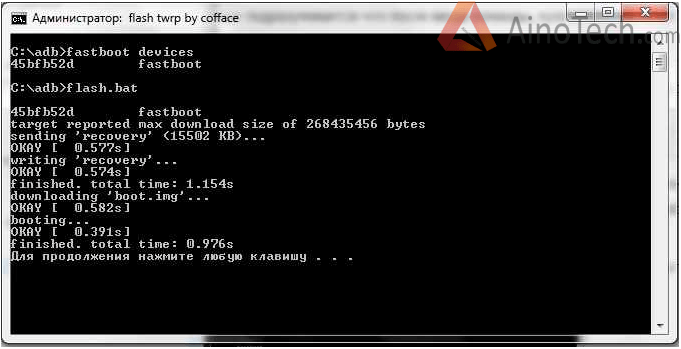Xiaomi redmi 3 Russian firmware with updates. Installing the official firmware
Firmware:
How to determine if the official firmware or "Vietnamese" is installed:
List of indices of official firmware:
7.1.2.0
7.1.3.0
7.2.1.0
7.2.4.0
7.2.5.0
7.2.6.0
7.2.7.0
7.3.1.0
7.3.2.0
7.5.1.0
7.5.2.0
8.0.1.0
8.0.2.0
8.0.3.0
Not official:
Official Global Firmware:
Official China firmware:
Other versions of official firmware:
MiFlash / fastboot- archive for installation via MiFlash or bat file in FASTBOOT mode
Recovery / System- archive for firmware through the built-in program "Update" or TWRP
China:
You can install the firmware via MiFlash with any firmware on your smartphone! You don't need to unlock the bootloader!
When flashing through TWRP (after full wipes), ALWAYS do a reboot from recovery to recovery and only after that start sewing! Otherwise, you risk getting a bootlap or installation errors!
The first start of the OS after the firmware lasts 15-20 minutes! If the dots on the screen below "run" - everything is fine, just wait ...
Installation official firmware via MiFlash
1. Necessarya) MiFlash flasher
C) On Windows 8 / 8.1 / 10, disable verification digital signature drivers.
Checking is disabled:
Checking is not disabled:
2.
Unpack the archive with the firmware to the C drive:
3.
Connect device to PC
A) download mode - locked bootloader
Method number 1:
1. Turn off the device.
2. Simultaneously hold down: Volume + and the On / Off button. In the menu that appears, select "download"
Method number 2:
1. Turn off the device.
2. Simultaneously hold down and hold both volume buttons, connect the device to the PC. As determined in the remote control, release the buttons. (usually 5-10 seconds)
Method number 3:
1. Turn off the device.
2. Simultaneously hold down all three buttons (both volume buttons and the On / Off button) and hold until the second vibration!
B) fastboot - unlocked bootloader or TWRP * installed on locked
1. Turn off the device.
2. Simultaneously hold down the Volume minus and the On / Off button, release after vibration.
3. A picture of a hare and FASTBOOT will appear.
4.
- update (Refresh) the list of devices and make sure that it appears in it (1, 2)
- select item (3) (saving is possible only with firmware in fastboot):
Flash all - flashing with clearing all data on the device
Flash all except data and storage - firmware saving personal and user data
- press the Flash button (4), the firmware process will go 
After successful firmware download, hold down the On / Off button and hold it until the first vibration!
When flashing via fastboot, the reboot is automatic!
Possible MiFlash errors and solutions
1. Missed hello packet, try to recover
- restart MiFlash, disconnect the body from the PC and re-enter the download mode, preferably NOT through the menu.
2. Not enough memory to process the command (little RAM)
- find a computer with a sufficient number of OP;
- use alternative method firmware (the state of the bootloader is not important);
- sew via fastboot (for an unlocked bootloader);
3. Reached the end of the file (0x80070026: Receiving hello packet) | End of file reached
- it helped as in point 1.
- or perhaps there is another version of MiFlash, put 2015.10.28.0.
4.0x80004005: Failed (remote: device is locked. Canot flash images)
- when trying to flash through fastboot on a locked bootloader. Sew in download mode.
5. Syntax error in file name, folder name or volume label
- trying to install the firmware for Recovery / System (* .zip). Archive for MiFlash with the tgz extension.
6.wait port ready to use
- clean up phone drivers, reinstall MiFlash
7. The required resource is busy (0x800700aa: open serial port "\\. \ COM3")
Xiaomi Redmi Note 3 Pro is too early to discount, although there is. The model turned out to be very successful, which won the love of not only mi-fans, but also other users. In this article, we will tell you in detail about all the obstacles that you will have to face in the process of installing custom firmware on your smartphone.
1. INSTALLING THE DRIVER ON THE COMPUTER
The first step is to install the driver on your computer. The most in a simple way is the installation of the Mi PC Suite program, which will automatically download and install all required drivers... If, for some reason, you were unable to install the drivers using this program, you will have to do it manually:
upload archive with drivers and unzip its contents to the "C: \ drivers" folder
connect your phone to your computer using a USB cable; open "Device Manager" on your computer
right click click on the "Unknown device" that appears and select "Update driver"
select the item "Search for drivers on this computer", find the folder with previously downloaded drivers and select it
confirm the installation, you're done 🙂
If you are still experiencing problems with the installation, then perhaps disabling the digital signature verification of the installed drivers will help you.
2. UNLOCKING THE LOADER
Now you need to unlock the bootloader on your phone. To officially unlock the bootloader on Xiaomi smartphone,.
3. INSTALLING A CUSTOM RECOVERY
Now you have to install custom recovery on your device.
To do this, strictly follow our instructions:
upload a custom recovery image in .img format, TWRP version 3.1.1-1 will do;
put your device into Fastboot mode by simultaneously holding down the power and volume down buttons until the fastboot logo appears;
connect the device to a PC;
open the folder with MiFlash and move the downloaded .img image into it. Then hold Shift on the keyboard and right-click on the folder space to open the context menu, in which select “Open command window”;
in the window that opens, type the command: “ fastboot flash recovery file.img”, Where file.img is the name of the downloaded custom recovery image. Execute the entered command by pressing the Enter button;
maybe the phone will reboot several times, after which custom recovery will be installed on it, and the device itself will be completely ready for custom firmware.
If suddenly you decide to flash an official MIUI version using custom recovery, then you have to patch the bootloader: in the TWRP menu (custom recovery), click “Advanced” -> “Disable verify”, then install the patch itself along the path /sbin/cofface.zip. If you are going to install custom firmware then this step should be skipped.
4. INSTALLING CUSTOM FIRMWARE
Are you still here? We praise your patience and dedication! And only now you can install custom firmware.
Follow our instructions further:
pre-download the firmware you like and GAPPS to it (a set of Google applications, its services and Google play, including) and copy them to internal memory phone;
reboot your smartphone into Recovery TWRP mode by holding down the power and volume up buttons until the “Mi” logo appears;
follow the path: "Wipe" -> "Advanced Wipe", check the items "Dalvik / ART Cache", "System", "Data" and "Cache" and then confirm the cleaning, either by clicking on the confirmation button, or by swiping on the slider below ;
now select the "Install" item in the menu, in the phone memory select the .zip firmware archive and, if necessary, the GAPPS archive;
use the slider or button to confirm the installation, then in the “Reboot” menu select the “System” item, which is responsible for rebooting into the system;
after rebooting, you configure the device as when you first turned it on and you are happy with the new firmware.
Subscribe:

Today it is very convenient to order any Chinese-made goods via the Internet. Basically, all purchased equipment works well and performs its functions, meets the criterion "price-quality". But there are situations when some gadget gives software glitch, for example, a smartphone Xiaomi Redmi, and the official service center no.
Instructions for flashing Chinese smartphone Xiaomi Redmi 3
In this case, the new product does not function due to a failure in operating system... This is a very common mistake, it visually manifests itself as a black screen, when you turn on the smartphone, it hangs. The task is to flash Xiaomi so that it starts working.
Procedure:
Important! During the entire procedure, voltage should not be lost or the battery should not be discharged.
- All factory settings must be reset. To do this, hold down the volume up button together with the power key of the device. The device will show signs of life.
- Next, change the interface language. This is important if you don't understand Chinese characters.
- Download all you need software products: drivers and official firmware files. Do not use third-party software from unverified sources. The link can be viewed in the video. So, the firmware has been downloaded, the drivers are installed.
- Run the installation software, allow it to perform the required actions.
- Install MiFlash according to the instructions.
- Open it and click on the "browse" button. Select the directory (folder) ROM. At the bottom of the dialog box, check the "flash all" checkbox.
- Click on the "reflash" button. The process of re Xiaomi firmware Redmi.
When finished, unplug the device and reboot it.
note! The start will not happen instantly. The phone needs to move away from shock therapy. It will take up to 10-15 seconds.
As you can see, nothing complicated. The interface is intuitive, even for a novice user.
Instructions for flashing a smartphone Xiaomi Redmi 3 for a new firmware, unlocking a bootloader, installation custom recovery TWRP, getting root superuser rights.
Flashing Xiaomi Redmi 3 using MiFlash for a locked bootloader
In order to flash Xiaomi Redmi 3 with MiFlash help, on your PC you need to download the latest version of the program - MiFlash
Then download the official (chi / en) or modified (rus) firmware for the locked bootloader for the MiFlash program and unzip it to any folder on your PC.
Launch the MiFlash program, and select the path to the folder with the firmware as in the picture.

Then you need to translate Xiaomi phone Redmi 3 into download mode, for this you need to turn on the phone and turn it on, holding down the “power” and “sound up” buttons at the same time, after vibration release the power button, the following window will appear: 
We press the "download" button and connect the phone when USB assistance cable to your PC, in the MiFlash program window, press the button refresh, your phone should appear. We press flash, and we are waiting for the completion of the process of flashing your smartphone, usually it lasts 3 - 5 minutes.
The process of flashing a smartphone Xiaomi Redmi 3 with unlocked bootloader completely similar to that with a locked one, except that you need to use the firmware for the unlocked bootloader.
Installing custom TWRP recovery on Xiaomi Redmi 3 phone with unlocked bootloader
We go into the folder: C: \ adb
Inside the folder, on any empty space (not on files in the folder, but on white), while holding the “Shift” button, right-click, in the drop-down context menu choose "Open command window".
Then the command line should open.
We reboot the smartphone in FASTBOOT mode. To do this, turn off the device and turn it on by holding down the “Volume minus” and “On” hot buttons. The logo will light up on the screen FASTBOOT mode with a hare, we connect the phone to a PC.
5.In command console insert the command fastboot devices and click on "Enter"
This command will show whether the PC sees your smartphone in this mode.
In response, you will see the device ID and opposite fastboot.


After successful flashing TWRP phone will immediately load into recovery. The default language is Chinese. To install any other language, you need to do the following:

Now, to enter custom recovery, you need to hold down the “Volume Plus” and “Enable” hot buttons, after the “MI” logo appears, release the “Enable” button, and hold the “Volume Plus” button until you get into the stock recovery from Xiaomi with a yellow background ... We select the item with "recovery" here and get into TWRP.
Everything!
Unlocking the bootloader on Xiaomi Redmi 3
Unlock bootloader on smartphone Xiaomi Redmi 3 possible on firmware 6.3.17
And so let's get down to unlock bootloaderXiaomi Redmi 3
1) Flash to phone ido_xhdpi_images_6.2.18_20160107.0000.12_5.1_cn via MiFlash in bootloader mode -
So that your third generation Hiaomi Redmi smartphone (including model Note 3) worked at the maximum performance level all the time, you need to monitor latest changes in the software for it. It is optimal if the latest firmware is installed on Xiaomi Redmi 3, and it can be updated “over the air”. If the phone has stopped updating, you need to personally monitor the firmware update for it.
With the advent of new firmware Xiaomi Redmi 3 will need to download and install it. But you need to be careful, because the quality of its work will directly depend on how you flash your smartphone. For example, many of those who independently reflashed the Xiaomi gadget like the unofficial Russian firmware for Xiaomi Redmi 3, where some additions are made to the main package of functionality. True, you must be sure that you have downloaded a high-quality firmware and adhered to all the rules for installing it. V otherwise even installing the original program, you risk harming the phone.
In any case, whatever firmware you decide to install, even nominally the most best program downloaded and installed at your own risk. Neither the manufacturer nor the software developer is responsible for the further operation of the gadget.
Today we will talk about how the Xiaomi Redmi 3 is flashed correctly. Follow these recommendations, and the result is likely to be good.
Downloading MiFlash
To install any new firmware, you must first download the program to your computer. Only after that we download the version of the software for the phone you have chosen to the same computer.
You can download the global version of the firmware on the official website. If you want to install the Russian-language modified version, then check that the addition in the form of the Russian language is the only difference from the official version of the software. A simple principle works here: the more changes, the more chances of bugs occurring during the system operation.
 The firmware is always replaced in the Download Mode, into which you need to transfer your phone before starting work. Switching to bootloader mode is usually done by holding down the volume up button when turning on the gadget. There you will see inscriptions, mainly in Chinese, but Download is also in English, like fastboot.
The firmware is always replaced in the Download Mode, into which you need to transfer your phone before starting work. Switching to bootloader mode is usually done by holding down the volume up button when turning on the gadget. There you will see inscriptions, mainly in Chinese, but Download is also in English, like fastboot.
Give gifts
Installing the firmware
Next, you need to connect the smartphone to the computer via USB cable... The device should show up in the MiFlash program. As a rule, the system does not see it right away, therefore, click "Update" in the program window. If everything is successful and the phone is recognized by the system, we start flashing it. For this: 
- Specify the path to the downloaded firmware in MiFlash;
- Press the "Flash" button;
- We are waiting for the new software to be installed.
When the procedure is completed, we restart the gadget. If everything went well, you will see that the firmware on Xiaomi Redmi 3 has changed, and you need to set the initial user settings.
Now you know how to flash Xiaomi Redmi 3 and how to update outdated software. But you must definitely adhere to the following recommendations in order to avoid unpleasant consequences: 
- You can reinstall the firmware an unlimited number of times, even more than three in a year, but make sure that it differs as little as possible from the official one;
- The third generation of Xiaomi smartphones, including the Note model, often has a locked bootloader. If this prevents you from making changes to the system, send an unlock request on the official Mi website;
- Before installing the new firmware, be sure to copy all personal data from the phone to a safe place, because they will be deleted;
- Sometimes the file software for the phone may not boot, and the main reason is the incorrect recognition of the smartphone by the computer. He can see the gadget only as a storage device, not a telephone. Therefore, change the connection type and everything will work out.





